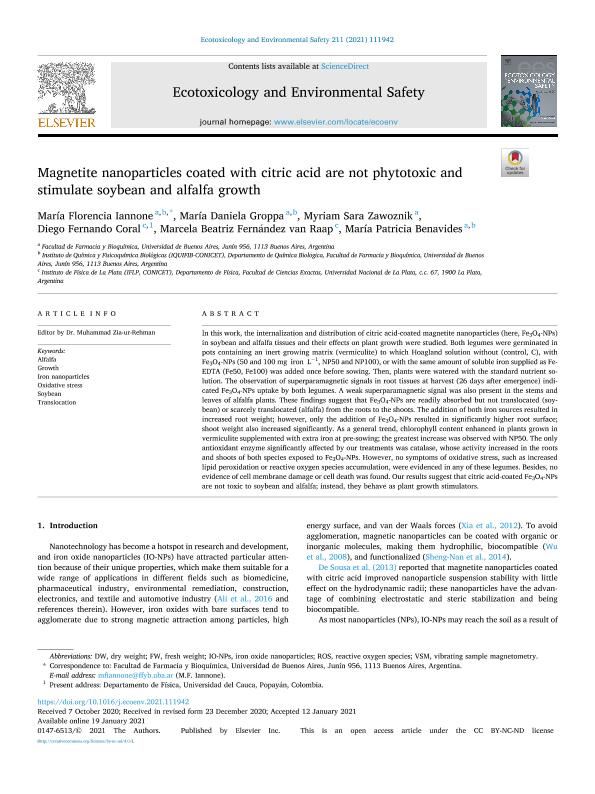Mostrar el registro sencillo del ítem
dc.contributor.author
Iannone, María Florencia

dc.contributor.author
Groppa, María Daniela

dc.contributor.author
Zawoznik, Myriam Sara

dc.contributor.author
Coral, Diego Fernando

dc.contributor.author
Fernández van Raap, Marcela Beatriz

dc.contributor.author
Benavides, Maria Patricia

dc.date.available
2022-12-14T11:25:26Z
dc.date.issued
2021-03
dc.identifier.citation
Iannone, María Florencia; Groppa, María Daniela; Zawoznik, Myriam Sara; Coral, Diego Fernando; Fernández van Raap, Marcela Beatriz; et al.; Magnetite nanoparticles coated with citric acid are not phytotoxic and stimulate soybean and alfalfa growth; Academic Press Inc Elsevier Science; Ecotoxicology and Environmental Safety; 211; 3-2021; 1-10
dc.identifier.issn
0147-6513
dc.identifier.uri
http://hdl.handle.net/11336/181070
dc.description.abstract
In this work, the internalization and distribution of citric acid-coated magnetite nanoparticles (here, Fe3O4-NPs) in soybean and alfalfa tissues and their effects on plant growth were studied. Both legumes were germinated in pots containing an inert growing matrix (vermiculite) to which Hoagland solution without (control, C), with Fe3O4-NPs (50 and 100 mg iron L−1, NP50 and NP100), or with the same amount of soluble iron supplied as Fe-EDTA (Fe50, Fe100) was added once before sowing. Then, plants were watered with the standard nutrient solution. The observation of superparamagnetic signals in root tissues at harvest (26 days after emergence) indicated Fe3O4-NPs uptake by both legumes. A weak superparamagnetic signal was also present in the stems and leaves of alfalfa plants. These findings suggest that Fe3O4-NPs are readily absorbed but not translocated (soybean) or scarcely translocated (alfalfa) from the roots to the shoots. The addition of both iron sources resulted in increased root weight; however, only the addition of Fe3O4-NPs resulted in significantly higher root surface; shoot weight also increased significantly. As a general trend, chlorophyll content enhanced in plants grown in vermiculite supplemented with extra iron at pre-sowing; the greatest increase was observed with NP50. The only antioxidant enzyme significantly affected by our treatments was catalase, whose activity increased in the roots and shoots of both species exposed to Fe3O4-NPs. However, no symptoms of oxidative stress, such as increased lipid peroxidation or reactive oxygen species accumulation, were evidenced in any of these legumes. Besides, no evidence of cell membrane damage or cell death was found. Our results suggest that citric acid-coated Fe3O4-NPs are not toxic to soybean and alfalfa; instead, they behave as plant growth stimulators.
dc.format
application/pdf
dc.language.iso
eng
dc.publisher
Academic Press Inc Elsevier Science

dc.rights
info:eu-repo/semantics/openAccess
dc.rights.uri
https://creativecommons.org/licenses/by-nc-nd/2.5/ar/
dc.subject
ALFALFA
dc.subject
GROWTH
dc.subject
IRON NANOPARTICLES
dc.subject
OXIDATIVE STRESS
dc.subject
SOYBEAN
dc.subject
TRANSLOCATION
dc.subject.classification
Otras Nanotecnología

dc.subject.classification
Nanotecnología

dc.subject.classification
INGENIERÍAS Y TECNOLOGÍAS

dc.title
Magnetite nanoparticles coated with citric acid are not phytotoxic and stimulate soybean and alfalfa growth
dc.type
info:eu-repo/semantics/article
dc.type
info:ar-repo/semantics/artículo
dc.type
info:eu-repo/semantics/publishedVersion
dc.date.updated
2022-09-20T15:51:02Z
dc.journal.volume
211
dc.journal.pagination
1-10
dc.journal.pais
Estados Unidos

dc.description.fil
Fil: Iannone, María Florencia. Consejo Nacional de Investigaciones Científicas y Técnicas. Oficina de Coordinación Administrativa Houssay. Instituto de Química y Físico-Química Biológicas "Prof. Alejandro C. Paladini". Universidad de Buenos Aires. Facultad de Farmacia y Bioquímica. Instituto de Química y Físico-Química Biológicas; Argentina
dc.description.fil
Fil: Groppa, María Daniela. Consejo Nacional de Investigaciones Científicas y Técnicas. Oficina de Coordinación Administrativa Houssay. Instituto de Química y Físico-Química Biológicas "Prof. Alejandro C. Paladini". Universidad de Buenos Aires. Facultad de Farmacia y Bioquímica. Instituto de Química y Físico-Química Biológicas; Argentina
dc.description.fil
Fil: Zawoznik, Myriam Sara. Universidad de Buenos Aires. Facultad de Farmacia y Bioquímica. Departamento de Química Biológica. Cátedra de Química Biológica Vegetal; Argentina
dc.description.fil
Fil: Coral, Diego Fernando. Consejo Nacional de Investigaciones Científicas y Técnicas. Centro Científico Tecnológico Conicet - La Plata. Instituto de Física La Plata. Universidad Nacional de La Plata. Facultad de Ciencias Exactas. Instituto de Física La Plata; Argentina
dc.description.fil
Fil: Fernández van Raap, Marcela Beatriz. Consejo Nacional de Investigaciones Científicas y Técnicas. Centro Científico Tecnológico Conicet - La Plata. Instituto de Física La Plata. Universidad Nacional de La Plata. Facultad de Ciencias Exactas. Instituto de Física La Plata; Argentina
dc.description.fil
Fil: Benavides, Maria Patricia. Consejo Nacional de Investigaciones Científicas y Técnicas. Oficina de Coordinación Administrativa Houssay. Instituto de Química y Físico-Química Biológicas "Prof. Alejandro C. Paladini". Universidad de Buenos Aires. Facultad de Farmacia y Bioquímica. Instituto de Química y Físico-Química Biológicas; Argentina
dc.journal.title
Ecotoxicology and Environmental Safety

dc.relation.alternativeid
info:eu-repo/semantics/altIdentifier/url/https://www.sciencedirect.com/science/article/pii/S0147651321000531
dc.relation.alternativeid
info:eu-repo/semantics/altIdentifier/doi/http://dx.doi.org/10.1016/j.ecoenv.2021.111942
Archivos asociados
